Luxury Branding The Future Leaders Of The World
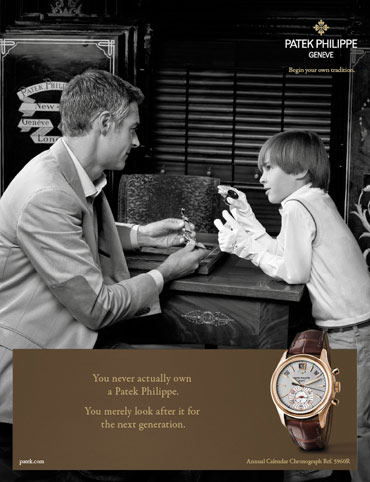
Watches have the same problem diamond jewelry has; it better be beautiful enough to keep forever, because if you try and sell it you'll discover there is no secondary market for it. No one wants the necklace your ex had waiting for you when you got back from Cozumel. "I've been doing a lot of thinking," he says, "about how easy it would be for you to get all the penis you want. Let's get married and make sure neither of us are ever happy. No, no, moving closer to your parents doesn't sound like a bad idea." Turning it into an heirloom keeps it out of the market and the supply stays regulated by the manufacturers, which I think is collusion but I'm no lawyer.
These ads can be seen in whatever rich people use to relax on Sunday afternoons, e.g. The Economist.
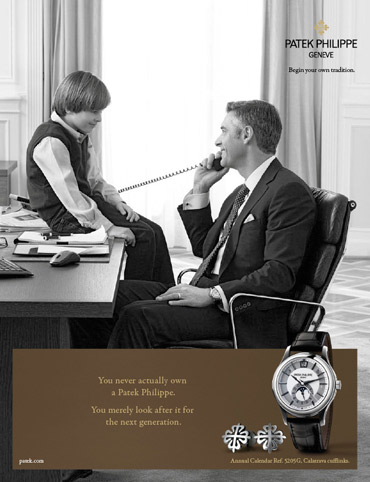
This is a brilliant campaign, for technical and artistic reasons. What is the brand that it conveys? Heirloom quality.
The ads use black and white photos: we've been around for a long time. Even the advertising campaign self-referentially broadcasts this-- it has been the same since 1996, i.e. longer than a 40 year old has been in the market for an expensive watch to notice it wasn't always thus, reinforcing the longevity of the brand.
I know you probably figure this ad isn't for you because you're not a railroad baron or a Rothschild, but ask yourself a question: have you seen this ad? Then it's for you. Time to learn why they know you better than you know yourself.
I.
The demo for this ad isn't the Rothschilds or the 1%: they don't buy based on ads. And they don't need to be told what constitutes quality or authenticity, they can tell, that's what boarding school was for. Everyone else is going to need to be hit over the head with the semiotics of quality--
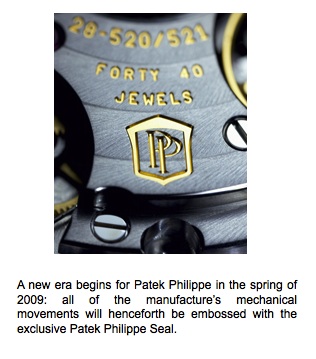
The target demo is not the 1%; the target demo is the Aspirational 14%. They know they are supposed to like quality and goodness and etiquette and discretion, but no one ever taught them what those things look like, so when someone does point it out to them they will go all in. Hence: anything in Trading Up. And they don't care
about the next generation. Not really. They don't want them to be eaten by zombies but anything past 2069 is of no consequence. What they do care about is how a
product brands them, what it says about them now, now that time is running
out. Can't afford to be subtle, which is the same thing as saying I'm willing to pay $10000 to get the message across. There's a difference between what the brand is and what the brand says about you. You'll pay 10x for the former and 100x for the latter.
Most products have quick, easy, memorable taglines, because most people are idiots. However, Patek Philippe's tag line is complicated and unmemorizable:
You never actually own a Patek Philippe. You merely take care of it for the next generation.
Which is the kind of tagline a person who wants to be a wealthy, complicated, precise man who doesn't fall for tag lines would fall for. The man in the photo is not a representation of the target demo; he is the impossible aspiration of the target demo. That explains how the kid can be in a sweater vest and not trying to murder his family.
The ad is pairing the legacy of the watch with the other imaginary legacy: the heritable family fortune. I don't know what the Dad in that picture does for a living, but you can be sure it involves a lot of money and the son will inherit it, along with a boat (below) and the means of production (not pictured).
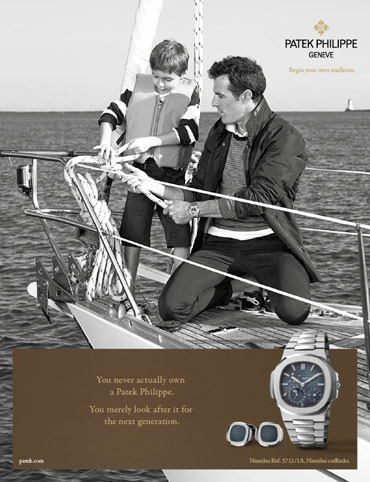
Also not pictured is $15T in debt and war with Iran, which he will also inherit, though he'll only be responsible for the former while the bottom 29% will only be responsible for the latter. Sorry folks, that's how it works, take it up with the Illuminati. Dad
is teaching the son the things a man should know, like how to tie bowlines, which Aspirational 14% didn't actually teach their own kids, which, and I hope you are appreciating the pattern, is precisely why this ad works. It's not representational, it's aspirational, i.e. can be done from the couch. "If I had a yacht, I would definitely teach my kid yachting. Time for a nap."
Some Patek Philippe owners do indeed know how to tie bowlines but the majority of potential customers are close-but-no-cuban to these aspirations, they wish they had enough to start a family legacy and get their name on the backs of orchestra programs because that would mean that they go to orchestras, that they are sophisticated, they have made it. Not Hollywood and dotcom made it, which was what they dreamed about twenty years ago, but the kind of made it where last names matter and "summer" is a verb.
You can't buy into class but people will try anyway, so the watch gets the nouveaux and nouveauxing rich as close to this lifestyle as they will ever get. Not only is it a visible symbol of their success but it broadcasts (as per the ad) that they are the kind of person that reflectively considers the next generation, what they will pass on to them, their legacy. (1)

"But don't they already have money to pass on?" It's not the money, but everything else but the money. Ryan Gosling's character in Drive inherited nothing from his dad except a Patek Philippe watch, but because it is a Patek Philippe we are to understand that it symbolizes the real gifts his Dad left him, like masculinity and courage and driving skills. The watch symbolizes the intangible legacy gifts that came along with it, but in real life there are no intangibles to pass on, so it is being used instead of those intangibles. It replaces the intangibles.
If this is confusing, remember that the watch is for the father. The point isn't to give it to the kid, the point is to convey the impression that he is going to give it to the kid. To convey the impression that he has other things to leave to the kid as well, just like those other high class Americans who pass on connections or defense attorneys or the Greek Prime Ministry. That's the kind of man he is.
It may also help to understand that Patek Philippe is not here competing against Rolex or Breguet; it is competing against vacations and cars and kitchen renovations. That's where $10k might have gone, so Patek must brand itself as an important generational necessity, a marker of European-style class, not a frivolous transient American-style expense.
This is the motivating force of Aspirational 14%: they have some money, wish they had a lot more, and want an ethical rationalization for their envy: it's for the kids. Keep telling yourself that. Dynasty is the wish-fulfillment of immortality through your bloodline. But it's better than nothing.
II.
Then the Great Crash happened. How did the ad campaign change to reflect the new economic realities?
The answer is in the above ads: there's father and son. What's missing? Mom. Doesn't she want a watch? Starting in 2009 she does, so tint the B&W to sepia and let's see what else modern women want.
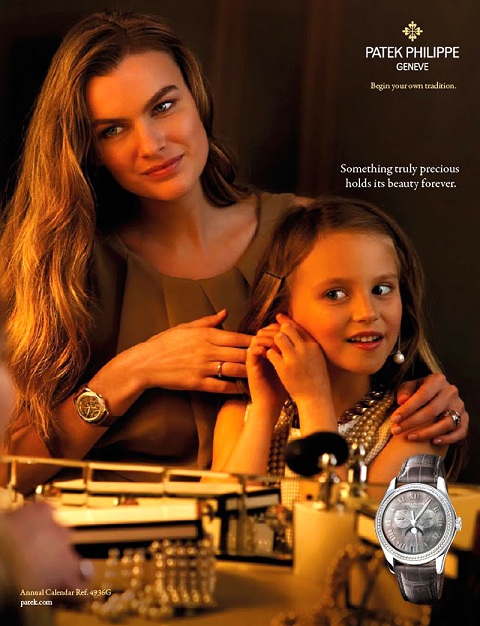
Nothing symbolizes the essence of a woman better than looking at herself in the mirror. "Something truly precious holds its beauty forever." A tag line even a Wellesley graduate can remember.
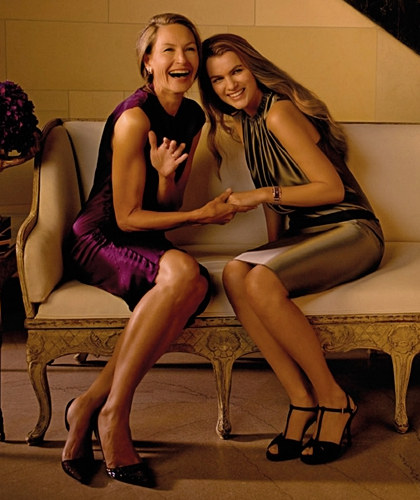
Older woman's left hand conspicuously assures us she's married. The
younger woman's conspicuously hidden in the mother's hand. Mom maintains control of the daughter's sex.
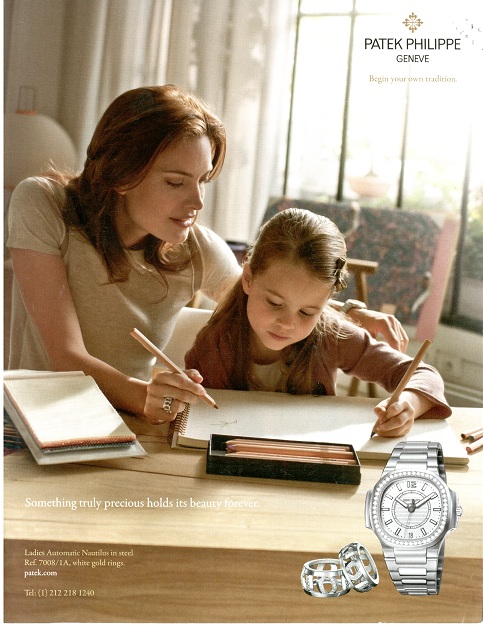
In these ads the legacy is quite different:
not wealth, or the business, or dynasty, but the hopefully enduring commodities approved for use by women: beauty, art, joy. It's mom and daughter and love, packaged in refined ostentationism, which is defined as subtle quality visible from 1000 yards. Not
pictured is Dad, because he's at work or one of those parties in Eyes Wide Shut.
A Financial Times
reporter incorrectly interpreted this as an expansion of the campaign to target
women. This is where my training in neurology is helpful: precisely where in the brain did the stroke have to occur to cause that kind of deficit in logic? Expansion? In 2009? That makes no sense: expensive jewelery,
like a car, is almost always purchased by or with the husband. The
wives of the Aspirational 14%, even if they have good jobs,
do not roll into a jewelry store by themselves and buy $10000 watches, unless they are the 0.5% or it is a present for their man. Hence, this is an ad for men, not women, which is also why this ladies' ad is prominently featured on the back cover of The Economist, the journal of record of Aspirational 14%, a magazine with 90% male readers. Through the triangular
magic of Freudian advertising you, the viewer, become the
Dad, with the aspirational images laid out for you: a beautiful and proper wife
with culture and delicacy, taking care of your perfect daughter, while you're in the shower scrubbing the scent of concubinage off you. So my silly joke was wrong: she's not a Wellesley grad, she's a Wellesley trophy wife. The Wellesley lets you both pretend you married her because she was smart.
III.
Something else about these ads: men and women never appear together.
Here we see the explicit pairing of same-sex members, never a family. They both get a watch but what the son inherits (everything) never overlaps with what the daughter inherits (a husband). "But that's how
the watch will be passed on." Haven't you been listening? These are brand ads, not product ads, they sell the aspiration, and, if I am
reading this right, that aspiration is to become European. Not Eurozone
European, of course, but Hapsburgs and Romanovs European.
Do these ads appear sexist to you? (2) Shouldn't some "intellectually curious" (the explicit demo of The Economist) woman somewhere
notice the contrasting aspirational message between the men's ads and
the "ladies''"-- and that word itself is a kind of branding-- ads? But 40 years after women's lib, this isn't such a terrible fantasy to women, either. They
might not want to give up their job as a CT surgeon, but they may
happily abandon their job as employee of MegaCorp if they could afford to. That's the fantasy, and this high class ad in a high class mag is saying high class women not-so-secretly want this.
Why reveal this desire now, in 20XX? Hmm, isn't it weird how just as soon as women entered the workforce it became completely impossible for a family to achieve the American dream without the woman in the workforce? Turns out that part of the drive to get women into the workforce was driven by... the workforce owners. Get it? Whenever you don't understand geopolitics just ask yourself where the lowest labor costs are, and wait for the headlines to read "human rights issues."
Of course women should be paid the same and should do whatever they want, but the point here is that that is a coincident benefit, the other purpose of it is to have a larger pool of labor willing to do jobs too good for Mexican illegals and not good enough for American men, i.e work in retail. Is it really liberating for women to work at Bebe but not be able to afford to shop at Bebe? Or is it just stupid, except for Bebe, which derives the full value of their employees' sex for $12/hr?
Here's an example: there's a dwindling but vocal segment of the female population that thinks that young women in the office should not have bare legs, that it is too sexualized. Bare legs are okay if you're a gold-digging whore, but "inappropriate" if you want to be taken seriously as a professional woman. Simultaneously, however, they believe professional office attire should be heels and a tight skirt. "It's called a business suit." It never occurs to them that the requirement of hose/stockings in the office was started way back when it was stockings, not bare legs, that was sexualized. You can go as far back as a Bob Hope movie where a sailor gets his best gal a pair of nylons (swell!) all the way to the 1986 scenes of Kim Basinger masturbating to a Kodachrome art show or stripping to the worst song ever in 9 1/2 Weeks, the intense eroticism depicted not by her naked body but by close up shots of her stocking covered thighs.
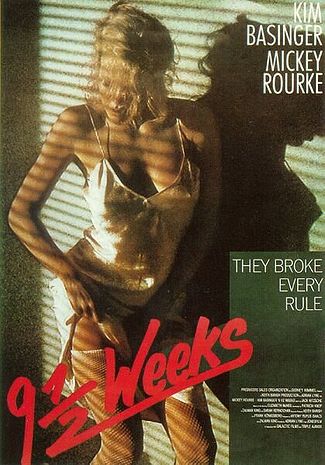
Once upon a time stockings were so fetishized they put them right into movie posters, nowadays the only place you're going to see them is MILF porn or all of Britain. And so the prohibition against bare legs has to be rethought-- is the worry that some 20 year old guy is going to get internet hard if he sees his coworker cross her bare legs? Who cares what 20 year olds think? The non-Lacanian, non-postmodern, super-duh conclusion is that the (male) office wanted their women all dolled up-- the trick, however, was that it convinced women to self-enforce this trend, to believe that the stockings helped de-sexualize the professional women, gave the power back to the women. No one man could pull off that kind of mass hypnosis, it has to be programmed into the Matrix. The system at one time wanted the office woman to be a simulacrum of a woman, all silhouettes and shades and posture, the stockings looking more like an idealized pair of gams than real gams ever could. Burning the bras wasn't nearly as liberating as getting rid of the pantyhose.
This is why the return of pantyhose is so revealing; hose represents a return to that sublimated female sexuality; to the more dangerous implicit, not explicit, masculine control of the sex. It isn't just like the 1960s, it is a retreat to the 1960s.
"Mr. Davis can't trust himself around you if you're naked," says the Human Resources department for a 50 year old mustachioed small business owner, "so if you don't mind we'd like you to cover up with this sexy lingerie. Thanks, you're a doll, now he can get some work done. He's going to need you to work late tonight. No, he'll drive you home after."
IV.
Back to Patek Philippe. That The Economist would want Patek Philippe to buy advertising space makes sense, it's good money, it decorates the pages of The Economist, and attracts an important demo that will pay the $130 subscription fee (the higher price is the magazine
equivalent of the Patek Philippe Seal). This demo has made The Economist
one of the only magazines to see a consistent growth in print
subscriptions. And it's part owned by the Rothschilds. How do you like
that?
But what is interesting is that Patek Philippe thinks the readers of The Economist are a good fit for this campaign. Are they insane? Perhaps not. On the one hand The Economist is an intelligent magazine that does promote free market, free thinking, "liberal" values in a mostly
non-partisan way; but if you imagine a magazine's ads as the unconscious
fantasies, the dreams, of the readers, then the wish fulfillment they
depict is not riches or bitches but a return to the old feudal order.
What you are seeing is the slow acceptance among an important demo, Aspirational 14%, of rigid class divides. They
may have some lingering disapproval about income inequality, hedge funds and genetic engineering, but it is tired of fighting a losing battle and you know what? all men aren't created equal, science keeps saying so and we pay our athletes accordingly, why not everybody else? Aspirational 14% doesn't want a monarchy,
but they sure as hell don't want democracy, not the American kind, not
anymore. I know, I know, you're rolling your eyes, you don't care what the readers of The Economist think or want, but the trouble is that as compared to the readers of Wired, Time, or The Atlantic, The Economist readers are more likely the ones who are shaping the new world order. That's why the classified ads in The Economist are for CEOs and the ones in The New Yorker are for mental institutions.
It is a sleight of hand on the American dream, and it's been a decade
in the making, the Great Crash only accelerating it. On The Apprentice the big prize is a Rolex and a job
with Donald Trump, but the person evaluating you for that position are
two generations of Trumps, take that American meritocracy! There's no illusion you can become a
Trump, the best you can do is become a wealthy employee of Trump. And you'll take it. But if The Apprentice is indeed a metaphor
for this European feudalism, then you should observe that the show's original judges were Donald Trump and his business partners (=American capitalism); Trump's kids were a later
addition. The evolution of the show was towards dynasty, not away from it, just as the Patek Philippe ads have moved, after 172 years in the branding business, towards this:
--towards this, during a time of social and economic upheaval, flattened earths, "student" revolutions in many Middle East countries and all out wars in many others; towards this, during the time the most important person in Europe is a woman; towards this in the pages of higher brow magazines for the "intellectually curious."
Anyone who thinks the profound changes happening in the world now are going to result in greater democracy or equality is not reading The Economist as carefully as he should.
----
2.
If you want to know what an aspirational image for a "ladies'" luxury watch targeted to actual ladies looks like, i.e. what women who will buy this watch want to think of themselves, you have to roll back the chronometer to 2003, back when the biggest crises facing the world were stem cells and Muslims:
Forget the watch, why do I suddenly want to buy shoes? (Because nothing says "I can be someone new" like new shoes.) The campaign was started in 1999 to target 28-35 year olds, but how many of those women could actually afford a Patek Philippe? Zero, hence the genius of the ad: build brand awareness. "We'll see you at the store when you're 40 and rich," the ad proposes, though it tacitly admits that a woman can't think more than 24 hours into the future unless it's to imagine becoming a trophy. Wife. NB: these women would be 40 now and on their second husband/watch.
Speaking of marriages, note that the single tweak necessary to distinguish the American vs. European ad campaign is to hide the wedding ring, Inception style, so you aren't sure.
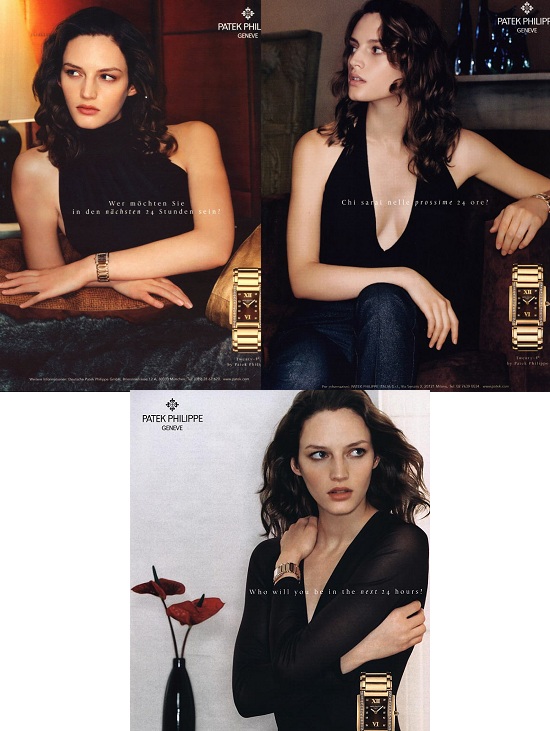
In an American ad, if a woman is possibly going to have sex, she better not be single. In Europe, she better be.
---
See also: If the rich youth can't get jobs, it means socialism has failed.
-----
http://twitter.com/thelastpsych

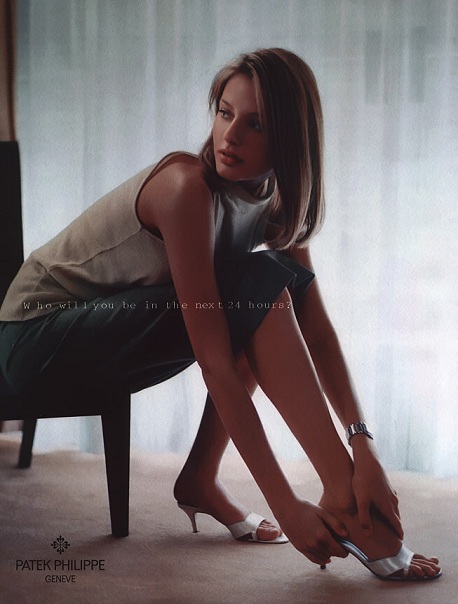
136 Comments